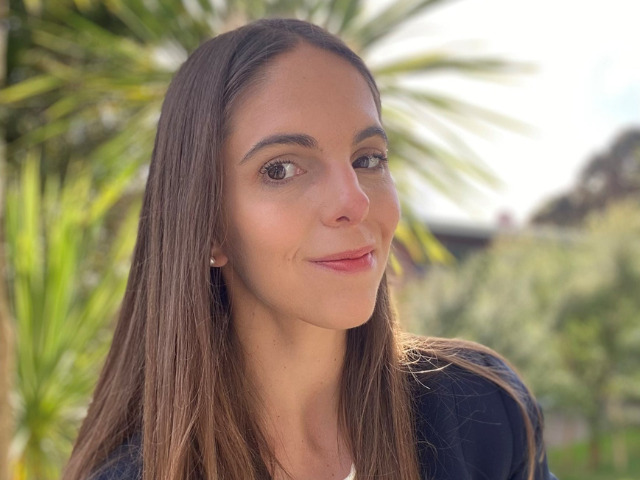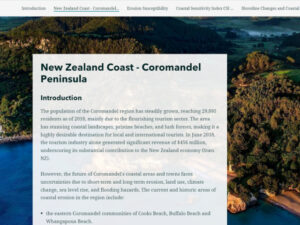
Alexia Scheuermann is an Environmental scientist in New Zealand who is passionate about protection of the coastal environment. Leading with Science®, she is striving to create public awareness about ocean and coastal vulnerability, and the need to develop sustainable strategies for coastal development and climate change.
Through her research studies at Massey University, Alexia has created an interactive Storymap on coastal erosion which explores the impact of coastal erosion and the challenges faced by the Coromandel Peninsula in New Zealand.
Here Alexia shares insights into her research and the challenges we face in ocean conservation.
What are some of the projects you are working on?
At Tetra Tech I have been involved in a range of major projects covering various aspects of the environment from closure plan modelling and auditing to conducting environmental impact assessments. Working alongside a team of specialists, we assess the impact of industrial activities and infrastructure development on communities and the environment. This involves tasks such as environmental impact assessments, baseline studies, audits, research, report writing, and data analysis.
What do you most enjoy about being a consultant with Tetra Tech Coffey?
The opportunity to work on diverse projects and make a meaningful impact. As a consultant, I get to collaborate with clients, stakeholders, government agencies and experts from different industries. This exposure allows me to constantly learn and expand my knowledge while tackling unique challenges. I also have the opportunity of helping our clients understand the potential environmental effects of their projects and assist them in minimising, mitigating, offsetting, or compensating for those effects.
I enjoy helping our clients meet their project objectives while ensuring compliance with rules and regulations.
What drew you to study and work in this field?
Coastal geomorphology is the product of complex interactions involving sea level change, tectonics, sediment supply, geology, wave, river, and tidal processes. The incredible diversity and complexity of coastal landforms, ranging from sandy beaches to coral reefs, captivated my interest.
Coastal environments play a vital role in the overall health of ecosystems and communities. I have always wanted to contribute to understanding and preserving these dynamic coastal systems, which led me to pursue a career in this field.
What are some of the challenges oceans and erosion pose to our environments, communities, and cities?
A significant percentage of New Zealanders (66%) and Australians (85%) live within 5 kilometres ((3 miles) of the coast, making sea-level rise a direct concern for many of us. Sea-level rise is primarily caused by the melting of polar ice caps and the expansion of ocean water as it warms. In New Zealand and Australia, it is projected that the sea may rise by up to a meter by the end of the century. This will result in increased coastal erosion and flooding, leading to damage to homes and infrastructure such as pipes, stormwater networks, bridges and roads.
Coasts and marine environments will face various challenges, including ocean acidification. It is estimated that oceans currently absorb around 25% of all carbon dioxide emissions (CO2). This process causes oceans to become more acidic. This change in pH levels affects species that rely on calcium carbonate shells, such as plankton, molluscs, and crustaceans, as they struggle to grow and maintain their shells when ocean waters become too acidic. Rising seas and coastal erosion also threaten all coastal species, creating a ‘habitat squeeze’ between coastal ecosystems and developed land.
Finally, the productivity of the oceans and the abundance of prey species like krill and plankton, which serve as the foundation of the food web, will be impacted by warmer waters and shifting currents. Any changes to these species will have ripple effects on other organisms. Additionally, warmer waters around New Zealand and Australia may facilitate establishing and spreading of invasive species and diseases.
As we face these challenges, questions will arise regarding whether we should rebuild damaged infrastructure in the same locations or consider relocation; we should invest on the protection and restoration of our coastal ecosystems (e.g. mangroves); we should prioritise emission reductions schemes and promote sustainable practices. These are decisions that we will need to make in the future.
Connect with Alexia at alexia.scheuermann@tetratech.com

The Story Map – Alexia Scheuermann
My story map was part of a research report aimed at assessing the current impacts of coastal erosion in the Coromandel Peninsula, New Zealand. Located on the North Island of New Zealand, the Coromandel Peninsula extends 85 kilometres north from the western end of the Bay of Plenty, forming a natural barrier protecting the Hauraki Gulf and the Firth of Thames in the west from the Pacific Ocean to the east.
The story map involved collecting secondary data on erosion rates, shoreline changes, and sediment transport to understand the extent of erosion. Using GIS tools and gathered data, vulnerable areas were identified based on geology, sea level predictions, land use, and exposure to wave energy. The idea behind the story map was to showcase the existing and potential impacts of coastal erosion and flooding on infrastructure and communities in three specific areas while also explaining the processes driving coastal erosion and flooding.
The main drivers of change in the study areas differ from other parts of Coromandel. The Firth of Thames is particularly vulnerable due to potential mangrove loss, sea-level-rise projections, and subsidence rates (vertical land movement). Conversely, the eastern coast of Coromandel experiences long-term erosion trends driven by historical and current land use practices.
View the Storymap online Coastal Erosion (arcgis.com)